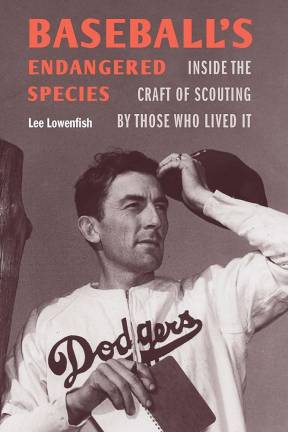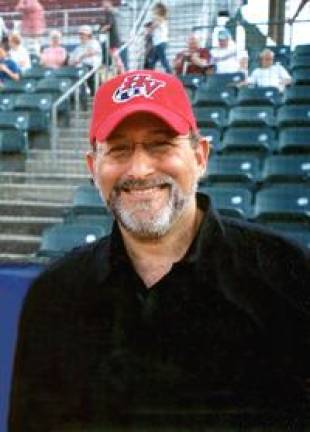Lifelong Love Of Baseball Yields New Book On The Art Of Scouting
Lee Lowenfish traces his love of baseball to watching the New York Giants in the Polo Grounds during the 1950s with his dad. It was the golden age of New York baseball. For every year from 1947 to 1958–except for 1948–one of NY’s three major league teams—the Dodgers, the Yankees, or the Giants—played in the World Series. Lee has lived on 104th St. on the Upper West Side for 40 years, and–not far from his boyhood home in the West 50s–he attended P.S. 69, which was demolished to make way for the Ziegfeld Theatre. He wrote his first book in 1978, and has remained a pundit and chronicler ever since.


Lee Lowenfish is the ultimate baseball historian. He’s written seminal books on America’s pastime for over four decades, ranging from 1980’s “The Imperfect Diamond: A History of Baseball’s Labor Wars” to the 2007 biography “Branch Rickey: Baseball’s Ferocious Gentleman” to 1984’s “The Art of Pitching”, which he co-authored with NY Mets ace Tom Seaver. An academic career saw him teaching in Baltimore colleges for more than a decade before returning to the city in 1976, but he remained a New Yorker to his core. He attended Bronx Science High School and has a bachelor’s degree in history from Columbia. He also holds a graduate degree and a PhD from the University of Wisconsin, Madison. Both family connections and witnessing the illustrious reign of the New York Giants in the 1950s transformed him into a lifelong superfan of the game he chronicles. Lowenfish has also lectured on the sport too many times to count, both in the classroom and on various panels, and he maintains an active blog at leelowenfish.com. His latest book, “Baseball’s Endangered Species: Inside the Craft of Scouting by Those Who Lived It,” is a meticulously researched and narratively thrilling exploration of what it took to discover and mold great players before the modern era of data analytics. We caught up with Lowenfish to discuss the book, what it really takes to determine player “makeup,” and what about the immortal world of baseball is inspiring him moving forward.
You’ve mentioned discovering your love of baseball growing up in New York in the 1950s. You were a Giants fan. How did the excitement of those years as well as your time studying history later at University of Wisconsin combine into the work you do today as a baseball historian?
It’s so deep in me because my father was a dermatologist and a very good athlete, and among his patients were two National League umpires: Bill Stewart, and Babe Pinelli, whose last game behind home plate was Don Larsen’s perfect game. I can remember him coming into my parents’ apartment and saying “Boy, that Johnny Unitas can really play football, can’t he!” I went to Wisconsin to study history, but I would go to Milwaukee, and the Braves were still there. I’m so proud of the fact that I saw Don Kessinger for the Cubs. I’ll never forget ‘68, my last year in grad school, we went to see the White Sox play the Red Sox in Milwaukee. Baseball’s always been an undercurrent for me. When I was teaching at Goucher in Baltimore, I’d have an opening day lecture. By the late ‘70s, my father had passed and my mother was ill, and I moved back to New York and started to write about baseball as a precarious profession. I’ve been doing that with occasional teaching until this very day.
What was your writing process for Baseball’s Endangered Species? Who did you talk to? What was your routine?
Since the pandemic, I was not fortunate to have a place to flee to on Cape Cod or in the Catskills where I could write. I basically wrote in my small study in my apartment on the Upper West Side. It’s just a half mile from Columbia–where I went to college–and where our baseball team is outstanding, by the way. It’s a defending Ivy League champion. My magic eight words I tell people is that I tried to “keep my forward motion” and “put in the time.” There’s no shortcut if you’re going to do it. I had wanted to do this book for decades. One of the first scouts I met, who’s got a chapter in the book, his grandmother was a patient of my father’s. Baseball is such a fabric in this country, and that’s why I’ve done my writing. Firstly on the reserve system in The Imperfect Diamond (1980), which was a very serious book. All my books have been somewhat serious, but the stories are what keeps me going. That will hopefully sustain baseball through the analytic phase.
Your new book is a hearkening back to a time when baseball scouting wasn’t so consumed by data analytics. It’s almost baseball’s more romantic past. Would you say that nostalgia is a big part of your book and what you’re trying to accomplish here?
One of the best descriptions I’ve ever heard of nostalgia is that it’s “history without the pain.” The thing that’s so important about baseball, and that the analytics people forget, is that there is pain built into baseball. You have to accept it. AJ Hinch, who got suspended for a year when the Houston Astros were using high-tech and low-tech cheating, was asked about makeup and chemistry on a team. He basically said he’d consider it if you put a number on it. To me, that’s so wrong. So, I don’t consider my book nostalgic, but I do believe in history and that there are connections between people who played in the past and those who want to make their name in the present and the future.
Could you summarize what makeup is and how it’s been lost?
You scout somebody the minute they leave the bus. You want to see how they react to the failure that is built into the game. It’s human nature that there are a limited number of jobs on the team, and that you’d almost root against the guy taking your at-bats away. Yet that’s not the way to build a team. Baseball in particular, there’s failure built into every pitch. There’s so many pitchers in the game. So a big part of noticing what kind of makeup a pitcher has is: does he accept losing without becoming a loser or hanging his head? I follow basketball and football ardently too. Bo Ryan [the retired Wisconsin Badgers basketball coach], had a great quote about measuring players by what it takes to discourage them.
What else are you working on? Do you have anything you’re looking forward to next, any events?
I’m glad you asked. I’ll give a talk at the Hall of Fame Cooperstown Symposium on Baseball and American Culture. It’s going to be on the original Angels in the Outfield. The one with Janet Leigh, where she’s a sport writer that domesticates Paul Douglas, who plays the manager of the woebegone Pirates. One of the reviewers said it was hokum, but it was so well done, and the cast was fantastic. My argument will be that it was really the last great baseball film of the post-WWII era. I loved the research. That’s what I’m exploring now.